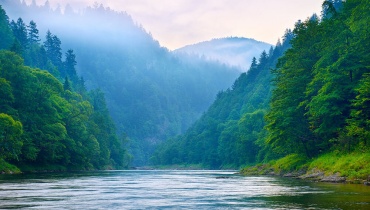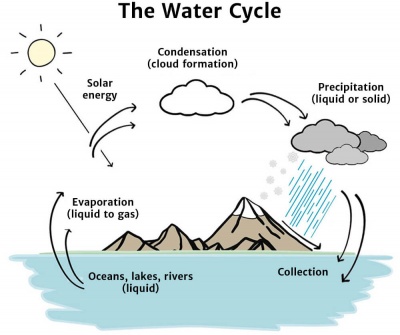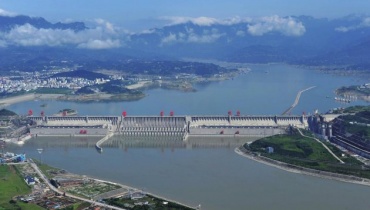Water Cycle
The Flow Goes On
In a Flash

Mountains are known as the ‘water towers' of the world and source between 60% and 80% of the Earth's freshwater.
The Water Cycle
Did you know that the Earth has been recycling water for over 4 billion years? The same water moves in an ongoing cycle between the Earth and the atmosphere called the water cycle. The water cycle is made up of four stages: evaporation, condensation, precipitation, and collection.
Burning Questions
What is the water cycle?
The water cycle describes the continuous movement of water between lakes, rivers, oceans, and the atmosphere.
During this cycle, water can be in the form of a solid (ice), liquid (water) or gas (vapour).
It might be hard to imagine, but the water you drink today is the same water that would have been used by ancient civilisations and even the dinosaurs! That's because the water cycle continuously recycles the Earth's water supply.

A lot of the Earth's water does not take part in the water cycle very often. Around 96 percent of the Earth's water is stored in the ocean.
What are the four stages of the water cycle?
One type of energy can change into another type of energy. Energy transformation means the changing of energy from one type to another, e.g. from kinetic energy to electrical energy, or from potential energy to kinetic energy.
-
1. Evaporation: As the Earth's surface is heated by the Sun, the temperature of the rivers, lakes, and oceans rises. This causes some of the water to evaporate into the atmosphere, where it turns into a gas called vapour.
Plants also lose water to the atmosphere through their leaves, in a process called transpiration.

-
2. Condensation: As the water vapour rises, it cools – this makes it turn back into a liquid, which forms clouds. This process is called condensation. Clouds are moved around the Earth by currents high up in the sky.
-
3. Precipitation: When the water droplets in the clouds become too large and heavy for the air to hold, they fall back down to Earth. This is called precipitation – and that's how we get rain, snow, hail or sleet!
-
4. Collection: The fallen water will be collected by rivers, lakes, and oceans, ready for the cycle to begin again. How it ends up back in these bodies of water depends on where it lands:
-
It may land directly in a river, lake or ocean
-
It may land on vegetation and evaporate back into the air, or be taken up by plant roots
-
In cold climates, it may build up over time on the land as snow, ice or glaciers – when the frozen water melts, it will soak into the ground or flow into rivers, lakes, or oceans
-
It may land on the ground and flow across the Earth until it reaches a river, lake or ocean – this water is called surface run-off
-
What Do You Mean?
The water cycle is the continuous movement of the Earth's water between rivers, lakes, oceans and the atmosphere.
Evaporation is the process where water changes from a liquid to a gas (vapour) due to a rise in temperature.
Condensation is when water vapour turns back into a liquid due to a drop in temperature, e.g. water vapour in the atmosphere condensing to form clouds.
Precipitation is the liquid and solid water that falls to the Earth from clouds – this can be in the form of rain, snow, sleet, or hail.
Collection is the process of the water that falls back to Earth being collected by rivers, lakes, and oceans.
Speedy Summary

The Three Gorges Dam is the world's largest power station in terms of generating capacity.
The water cycle is the ongoing movement of the Earth's water between rivers, lakes, oceans, and the atmosphere.
Teacher's Toolkit
Take this to the classroom!
Curriculum ready content.
